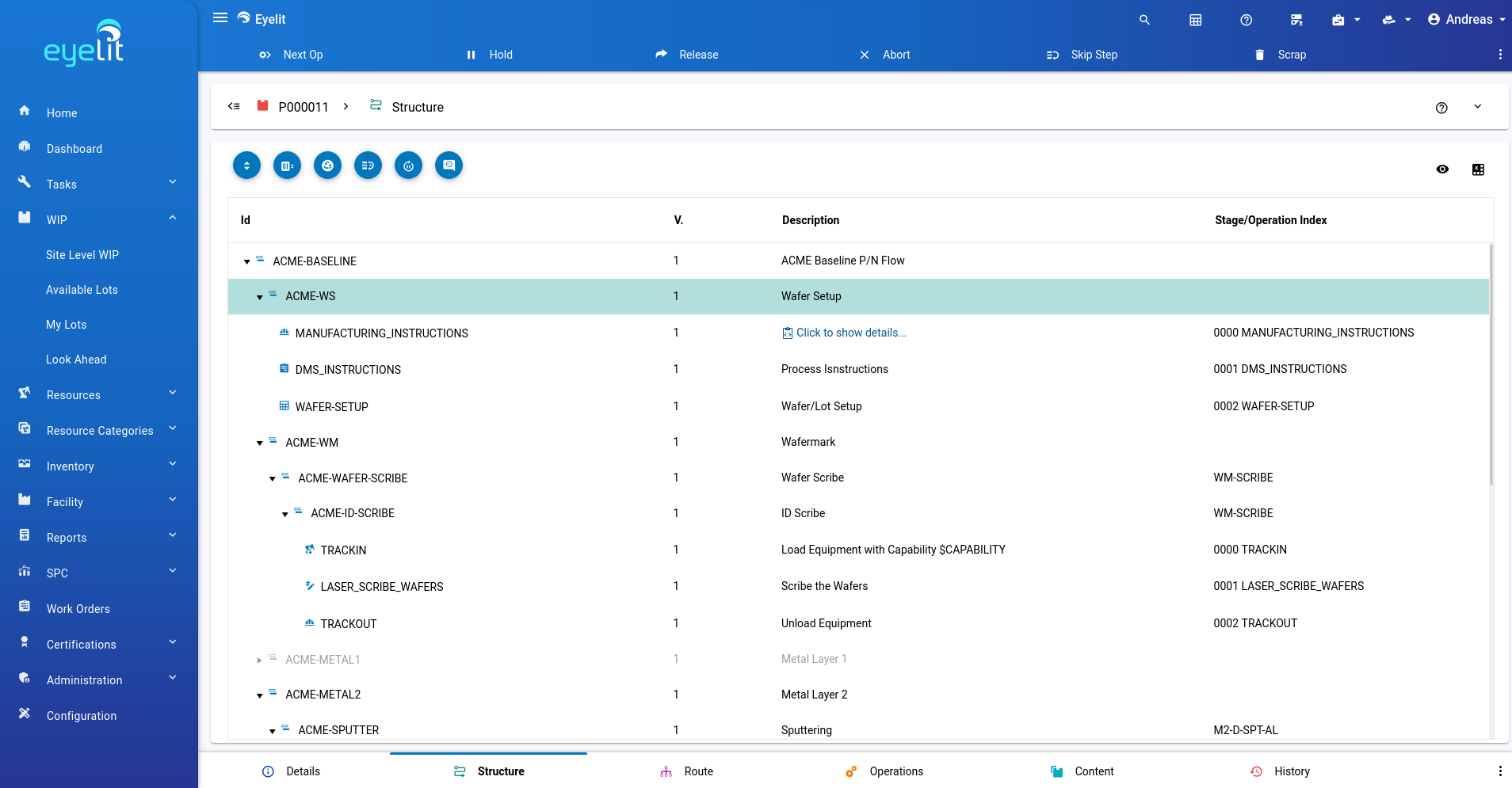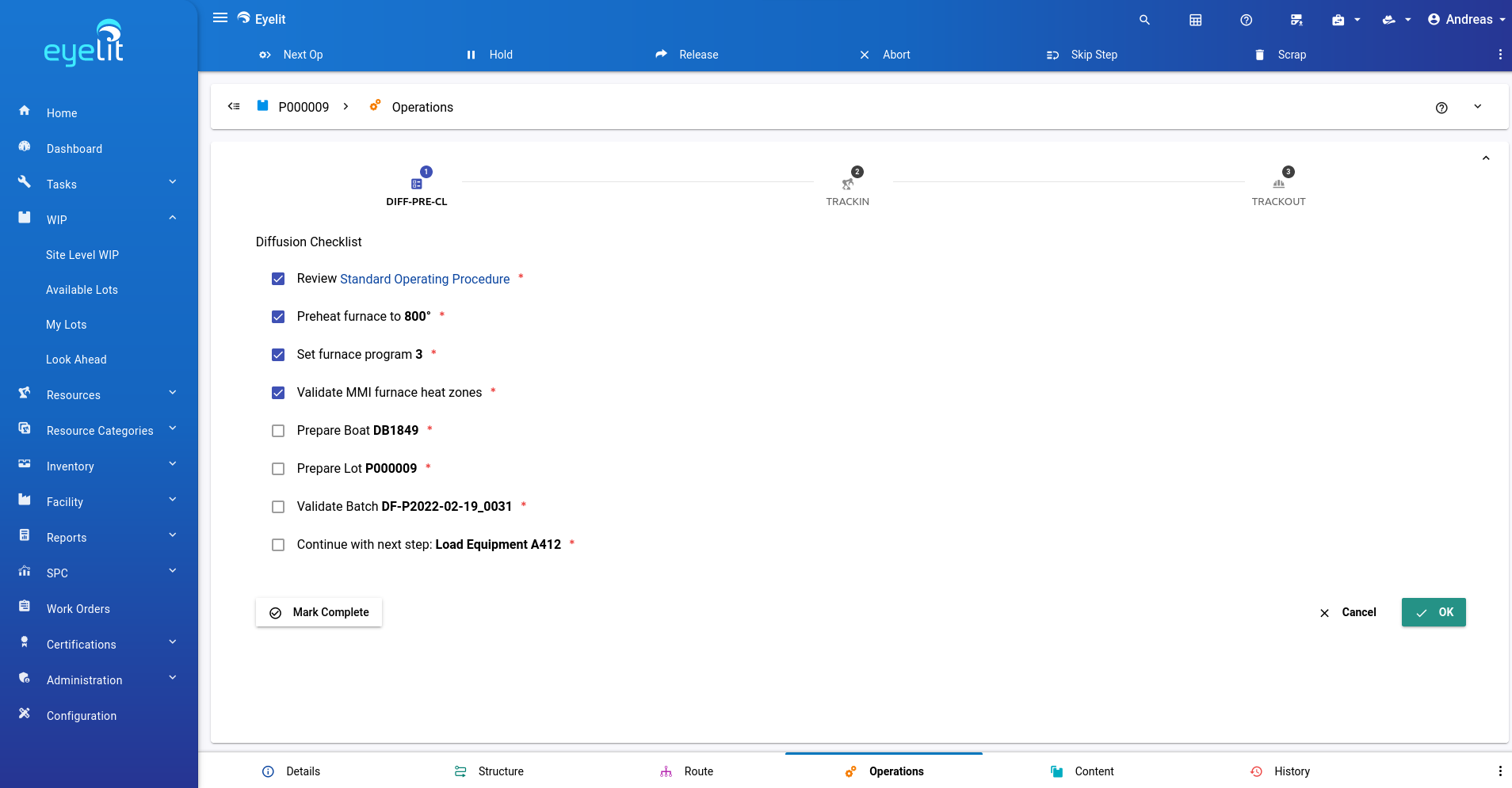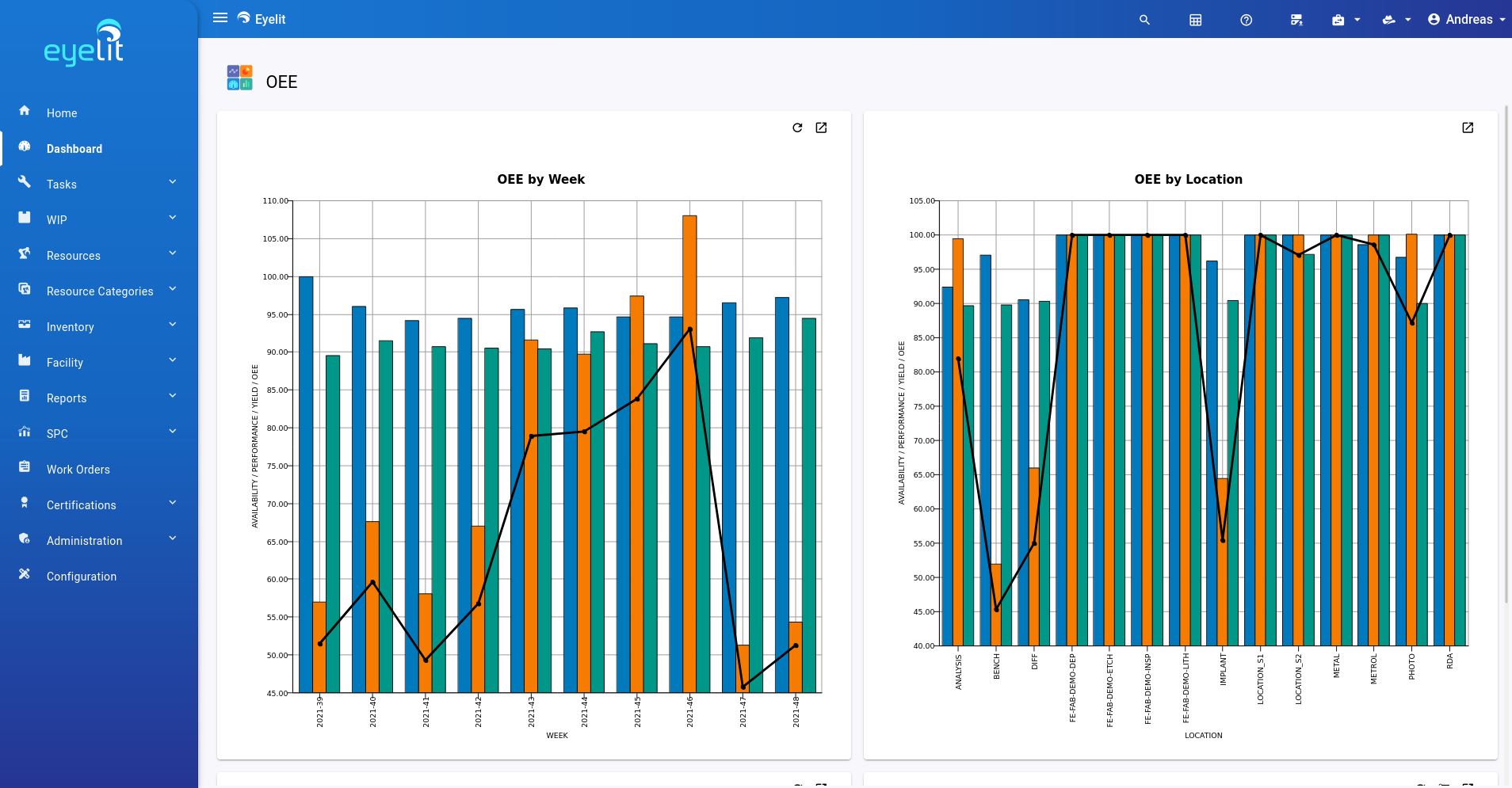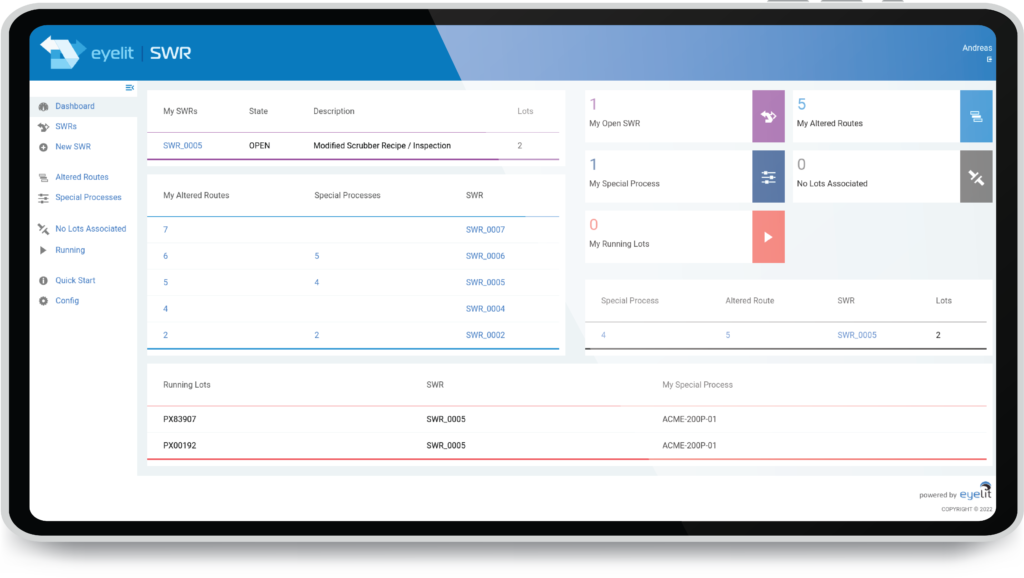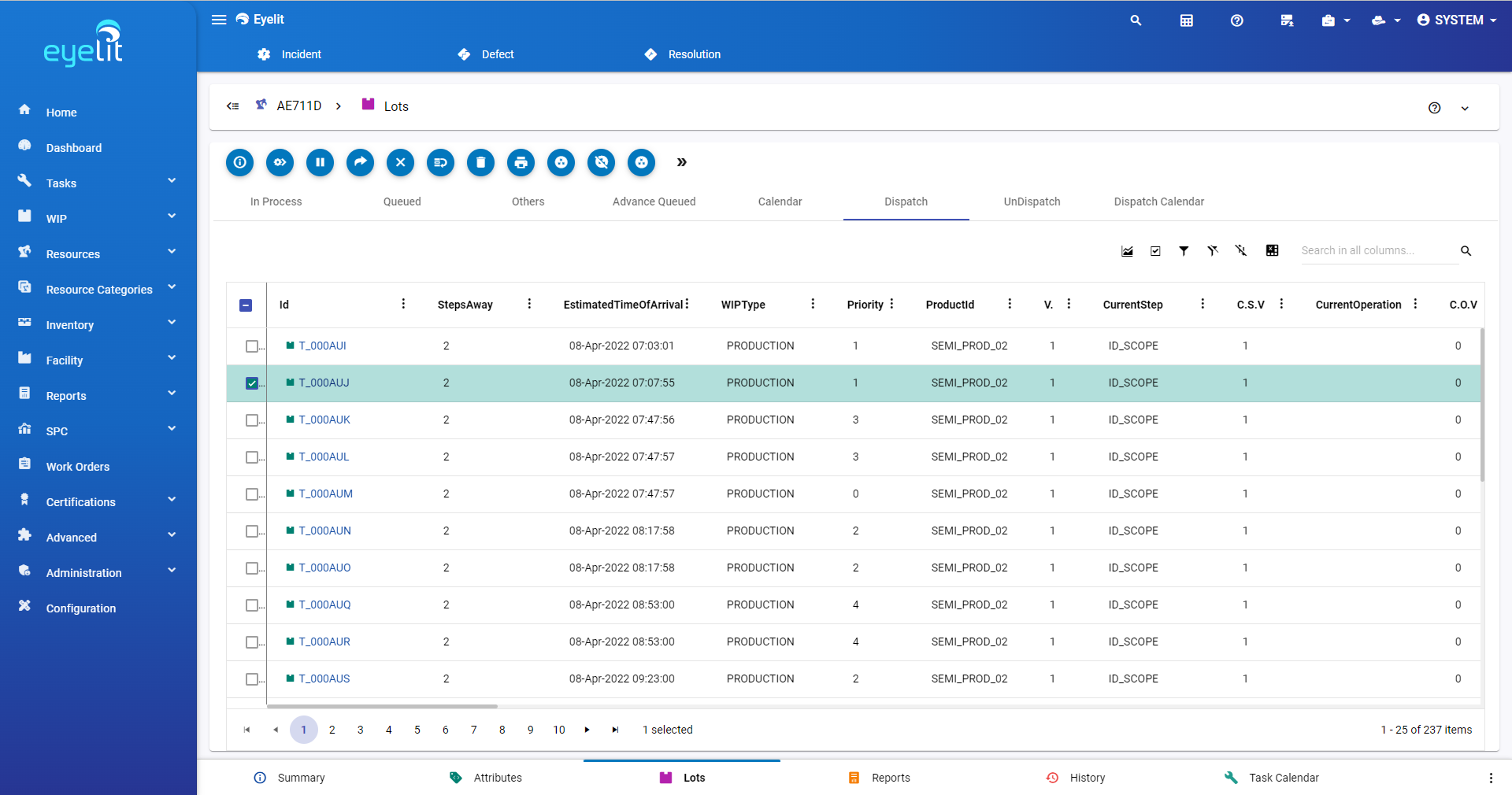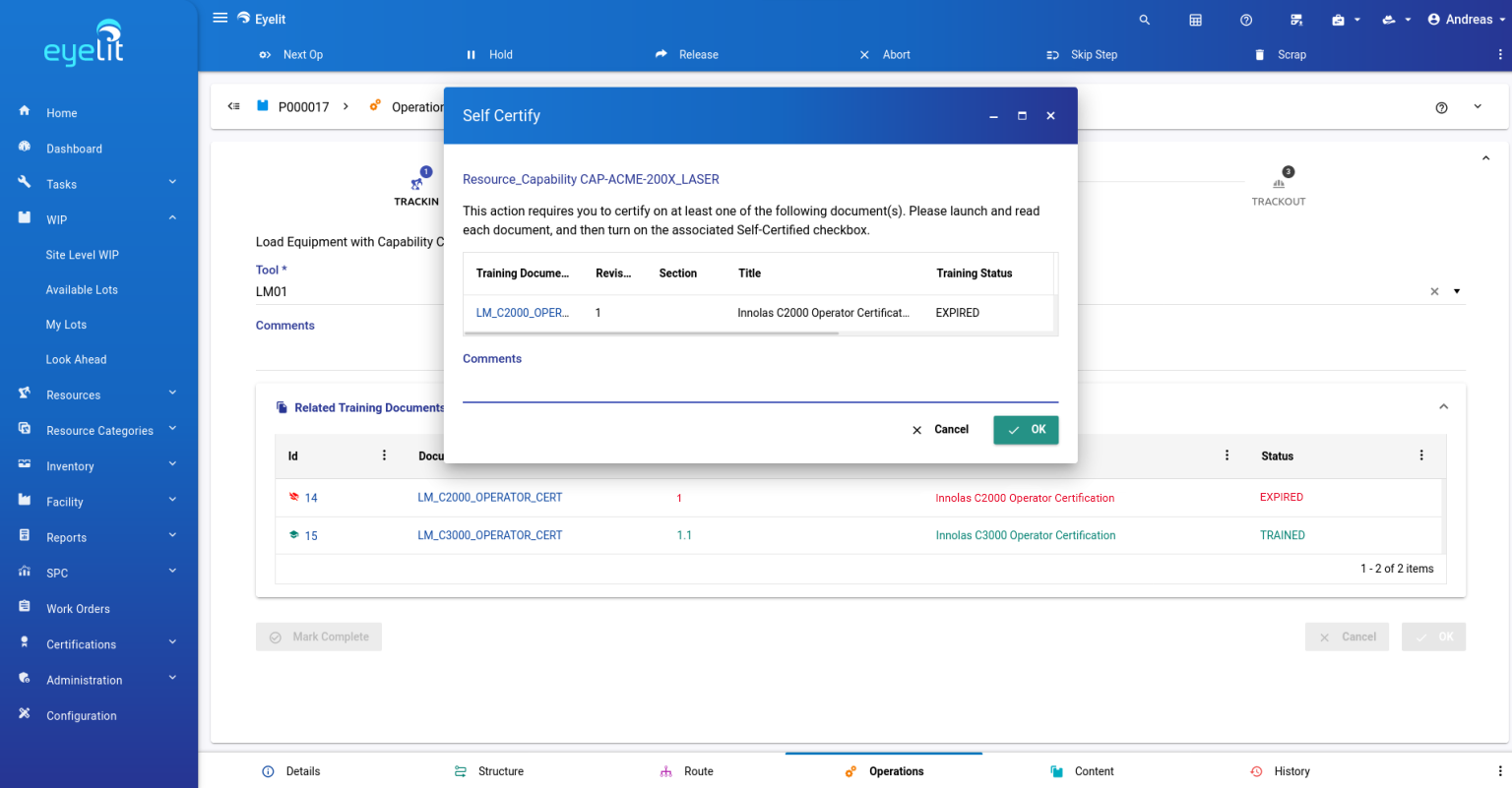EYELIT MANUFACTURING EXECUTION SYSTEM (MES)
At the heart of our solutions is Eyelit MES, the core system augmented by optional modules. Those share the same event-based workflow engine throughout the product suite, with configurable scenarios that evaluate current conditions to control and direct activities.
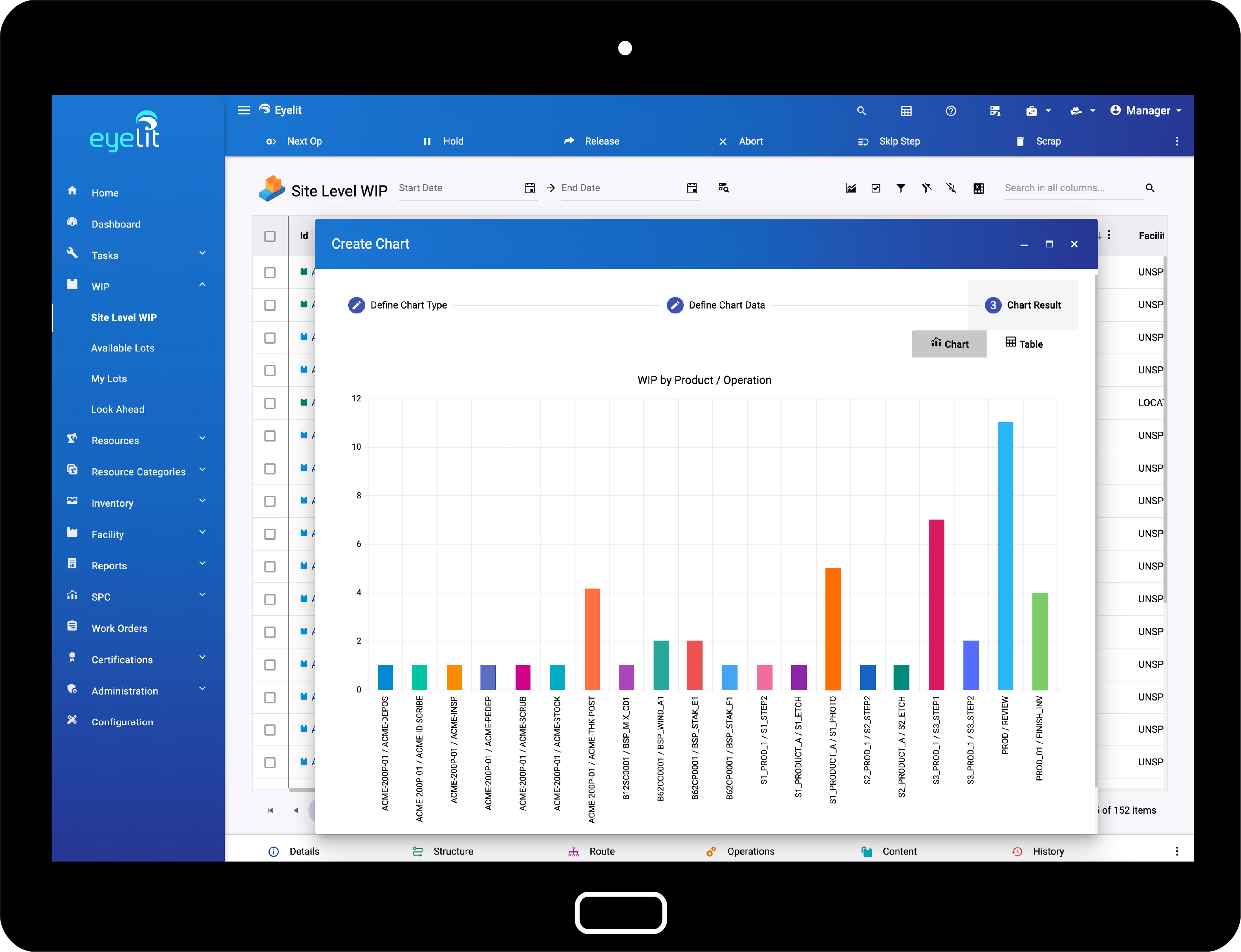
Eyelit MES, is a next generation, platform-independent, manufacturing execution system, providing the broadest set of functionalities for coordination, control, and optimization of a manufacturer’s business and production processes. Starting with the initial order receipt to finished goods, Eyelit MES manages the flow of critical information across the enterprise.
Personnel is armed with the resources to make even the most complex factory operations efficient and easier to manage. Eyelit MES enables customers to reduce or eliminate paper to improve efficiency with real-time manufacturing and quality controls. Specifications for version-controlled products, processes and instructions prevent oversights, capture data, enforce SPC, and counteract contamination even in controlled (clean room) environments.
The system includes distributed Bills of Material (BOM) and inventory management capabilities with complete traceability down to the source vendor lot and/or unit level. History of all activity including splits, merges, reworks, batches, and usage of materials, durables, and equipment is maintained for 100% traceability and is easily accessed for the full spectrum of reporting needs. With mobile access to real-time alerts, KPIs, and dashboard drilldowns personnel can quickly make informed decisions.
Time is Money
Eyelit MES can be rapidly deployed in a matter of weeks, not years. This is achieved using unique out-of-the-box functional components that were created for every primary need encountered when modeling manufacturing operations. Eyelit’s extensive set of business operations was developed in conjunction with key industry manufacturing leaders and enabled Eyelit to be the undisputed leader in implementation time. Common deployment time can be as little as half the time and one-third the total cost of competing solutions.
Control
End users of the Eyelit MES effortlessly create personalized views of the production operations for which they are responsible. From configuring logical representations of facilities to configuring all of the resources within them, users can:
- Monitor and track everything from inventory and serialized production units to people and equipment on the adapted application.
- Focus on execution strategies and continuous improvement by utilizing the numerous out-of-the-box operations for starting and stopping equipment, collecting critical data, consuming material, tracking statistical process control, etc.
- Detect problems before they happen by configuring the codeless condition and event manager to automatically respond to unwarranted or unwanted conditions within your facility.
- Feed production information forward for auto decision-making on unit-specific processing parameters.
- Capture and control defects, and subsequently resolutions, to correct and prevent future replication of common issues.
- Stay in compliance with regulatory standards by verifying and validating product builds to a bill of materials (BOM).
- Record complete transactional history with all relevant transactions including, electronic signatures for eDHR and compliance with FDA Regulation 21 CFR Part 11.
- Enable paperless manufacturing and dramatically reduce the cost of goods produced.
- Configure executive dashboards and other real-time reporting screens in seconds.
- Monitor and respond in real-time to inventory changes using the Key Performance Indicators (KPIs) module which includes built-in auto-alerts and paging capabilities.
- And much more.
Eyelit Asset Management (AM)
Keep all your production assets serviced and operating smoothly. Electronically manage equipment, facilities maintenance, and technician tasks with alerts, scheduling, status reporting, and fully documented task lists.
The Eyelit Asset Management application is a comprehensive solution used with or without Eyelit MES to monitor, manage, control key equipment, spare parts and other assets used in the manufacturing enterprise. From facilities to production, Eyelit’s Asset Management solution arms executives, managers, and technicians with information on how assets are performing. They provide real-time status of scheduled/unscheduled maintenance and spare part activities, as well as complete history for process and cost analysis.
Keep all your production assets serviced and operating smoothly.
Monitor, manage, control key equipment, spare parts and other assets from all your devices.

Alerts, scheduling, status reporting, and fully documented task lists.
Arm executives, managers, and technicians with information on how assets are performing.
Complex Equipment Made Simple
Eyelit Asset Management makes configuring complex equipment easy. Create parent/child relationships, corresponding capabilities, and state-transition mappings. Manage every component of the equipment and control its behavior during manufacturing and maintenance. Associate relational “indirect” equipment, such as a facility chiller where a disruption in the “indirect” device may affect the performance of the manufacturing device. Or add a “direct” relationship whereby a child may automatically change the state/status of the parent tool.
Top Performance Management
Efficiency is crucial for any asset maintained by the manufacturing organization. Eyelit Asset Management exposes every behavior and characteristic to monitor and track performance and efficiency. Built-in warnings and alerts can be triggered when equipment fails to perform as desired. If equipment warranty is a concern, all performance and maintenance history is recorded and tagged to the equipment. This information can be accessed at any time or printed and reviewed with your vendor.
Built-In Inventory Control
Eyelit Asset Management’s built-in inventory control module allows technicians to monitor the availability of consumable resources as well as available spare parts. Consumption of material is automatically performed and decremented against its source location. Spares are tracked with a complete history and current location.
Informative Reporting
Using the Eyelit interactive dashboards, customer views can be created in seconds, building upon out-of-the-box reports, Overall Equipment Efficiency (OEE), Mean Time Before Failure (MTBF) and Mean Time To Repair (MTTR) are just a few reports which keep the key personnel apprised of any critical operational signals that may need attention. These and other reports are easily created, printed, exported, and reviewed using the configurable screen and filtering agents.
Enterprise Information
In addition, to using it as an Eyelit module, Eyelit Asset Management can be deployed as a standalone application or connected to almost any other software application, using Eyelit FactoryConnect’s proven integration framework. Simply integrate to an MES, extend the solution by adding automatic reconciliation of inventory usage with ERP systems, perform tool-based Statistical Process Control (SPC) on collected data, display work instruction from Product Data Management (PDM) application or simply share information in real-time with equipment vendors. Eyelit Asset Management makes critical asset information easy to control and exchange through this extensible module.
Eyelit Special Processing (SWR)
Accelerate New Product Introductions (NPI)
Special Work Requests
Eyelit Special Processing/SWR™ is used to model Research and Development flows and special processing scenarios. The experimental processing capabilities enable process engineers, on an ad hoc basis, to easily insert and remove steps for R&D lots on the fly. A special route can be used for lot creation without affecting the original route. Specific instructions can also be added for sub-steps to direct operators, engineers, and technicians to test and/or observe behaviour for R&D lots.
Experiment Management
Advanced features are available for Special Work Requests (SWRs) to control complex experiments. When creating an SWR, the engineer can control where splits shall occur and where steps might be removed or added. Configuration of attributes, conditions and other similar functional concepts are also utilized to accomplish more specific scenarios. SWRs can also contain parameter overrides (for example, variables passed to equipment recipes to adjust processing). Once defined, SWRs are assigned to a Lot or set of Lots that interpret and utilize the SWRs as they traverse the process. At defined steps, the SWR enforces the splits, deviations, and skip step requests, as well as variable overrides. A complete history with cross-references is maintained for complete traceability.
Approval Signoffs
If using Eyelit QMS forms may be used for routing SWRs through approval processes and signature hubs prior to release. Fields may be used in the forms to store and retrieve data and may be tailored to best suit specific needs.
Eyelit Advanced Dispatching
Automate Decisions for Efficient Manufacturing
The Eyelit Advanced Dispatching module extends the capabilities of Eyelit MES with configurable rules, filters, and conditions to prioritize material processing at equipment or workstation for each step of a manufacturing route/build order. The real-time conditions are evaluated for each unit of equipment and/or workstation, and lots/batches/orders in the queue when an operator or automation requests the system to advise which material should be processed next.
The dispatcher can incorporate many configurable criteria for a location/equipment ID to aid decisions that are otherwise difficult for people, Material Control Systems (MCS), Automated Material Handling Systems (AMHS), and Automated Storage and Retrieval Systems (ASRS) due to competing priorities such as meeting due dates, changing customer priorities, avoiding bottlenecks, and optimizing equipment and material utilization.
Extends the capabilities of Eyelit MES with configurable rules, filters, and conditions to prioritize material processing
Evaluates each unit of equipment and/or workstation, and lots/batches/orders in the queue
Incorporates many configurable criteria for a location/equipment ID to aid decisions that are otherwise difficult for people, MCS, AMHS, and ASRS
Configurable Rules for Fast and Efficient Deliveries
Prioritization rules enforce filtering decisions for particular lots by ensuring that specific attributes and parameters are compatible with current equipment setups and capabilities to prevent misprocessing. The dispatcher can indicate which lots should be batched or processed in series and when changeovers are recommended to optimize equipment utilization. The dispatcher also considers time constraints based on the minimum and maximum process timers between steps that monitor time-critical processing to comply with specifications. These features prevent misprocessing and unnecessary rework or scrap.
The system can be configured to feed data forward through variables so that downstream steps can use the data to pre-select different tool/recipe combinations for a lot, based on prior processing results. The dispatcher evaluates trade-offs to determine the real relative priorities, which are constantly changing in dynamic manufacturing environments and recommends the best choices to achieve overall business goals.
Rule factors
Some of the many factors that may be incorporated into configurable multiple criteria dispatching rules include:
Rendering
Dynamic dispatching also incorporates configurable display rendering schemes to highlight current condition-based priorities. For example, hot lots and lots with critical process timers might be displayed in different colors, and engineering lots may be grouped in different sections. The dispatch list for each tool may also be invoked interactively by clicking on a configurable icon of the tool in the factory map display. These visual indicators make it easy to recognize what to work on and when dynamic relative priorities change.
History and Conformance
When a lot is moved into a step, the order from the dispatch list can be stored in the history of the lot. This information can be used for conformance tracking. When a lot is loaded into a tool, the historical lot information can include the dispatch order of the lot for the equipment that was chosen during the load operation (or sent via Automation). Compliance may be calculated to be the number of times the user selects a lot with a ranking that is within the top n on the dispatch list.
Eyelit Operator Certification
Operator Training and Certification Checks for Quality Control
The Eyelit Training and Certification module provides granular control of document access and execution of manufacturing operations within process steps. It tracks changes to document records certification levels of Trainers and Operators, monitors training schedules, and can send out email notifications of new revisions.
The information it manages enables a conditional element in the Eyelit work instructions procedural processes. It can verify an operator’s training certification level prior to executing specific steps through controlling access to viewing specific work instructions and executing related operations like loading a tool or tool recipe, based upon the training documents required for each operation within a step.
The Document number and revision provide a hyperlink to each Document in an external document management system or folder so that users can quickly access the document PDF files if certified.
Equipment Technician Certification for Asset Management
Similar to MES operator certification controls, equipment technician certification controls can be used for maintenance and repair tasks in the Asset Management module. Only trained users may perform maintenance and repairs on specific tools.
Usage-based expiry Options
Certifications may be configured to automatically expire when a certain period elapses in which an operator has not loaded the affected tool, or since a technician has performed the affected maintenance task.
IP Shield
The Eyelit IP Shield module provides advanced functionality for shared manufacturing sites, such as foundries and research and development consortium facilities. IP Shield supports NPI (new product introduction) requirements and regulations such as ITAR and Trusted foundries by enforcing intellectual property (IP) and security procedures to ensure the protection and privacy of confidential and/or restricted product designs, process flows, work-in-progress (WIP), etc… It protects critical information of the various members and/or customers who share information within Eyelit’s software. Users may be are restricted to seeing only their own product specifications, tools, recipes, documents, and WIP, Etc.
This module was developed in collaboration with prestigious R&D consortiums to advance technologies in microelectronics and nanotechnology. IP Shield is used by the member companies for the development and manufacturing of applied electronics products including, semiconductors and MEMS devices.
